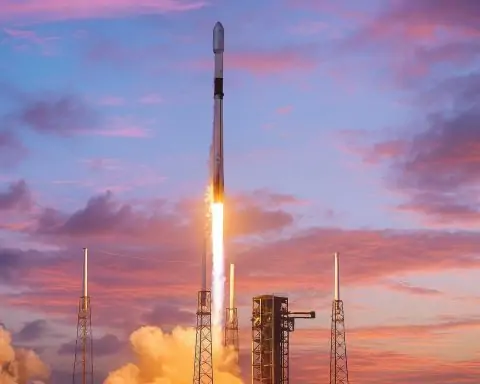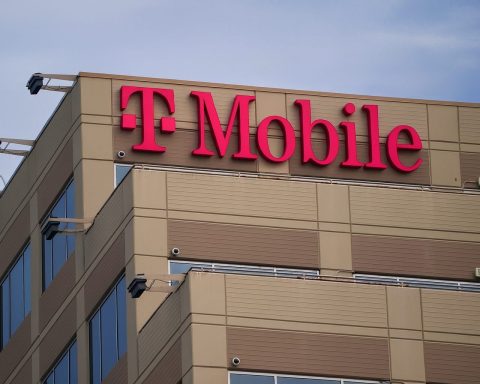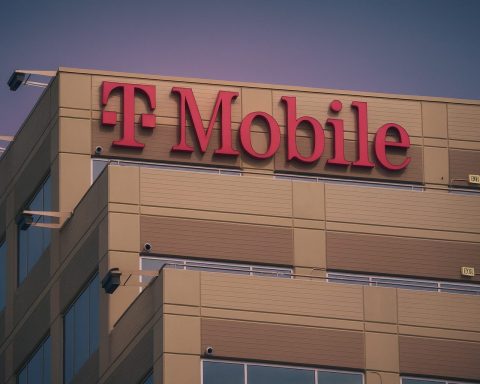- T-Mobile’s satellite service, T-Satellite, is now live nationwide and out of beta, making it the first major U.S. carrier to offer direct satellite coverage for ordinary smartphones.
- The service piggybacks SpaceX’s Starlink satellites and requires no extra antenna or app, automatically connecting when the phone can see the sky.
- T-Satellite relies on a constellation of over 650 Starlink satellites and initially supports SMS and location sharing, with MMS partially supported and iPhone MMS to follow.
- Intro pricing is $10 per month for a limited time, rising to $15 later, with top-tier plans such as Experience Beyond at $100/month and Go5G Next, and non-T-Mobile customers able to sign up for $10 during the intro period.
- Compatibility includes 60+ smartphone models, such as iPhone 13 and newer, Galaxy S21 and later, Pixel 9 series, and many Motorola and OnePlus devices, with unlocked devices and eSIM required for non-T-Mobile users.
- Coverage blankets the continental United States, Hawaii, Puerto Rico, and parts of Alaska, with roaming and offshore expansion planned through partnerships.
- When connected, the phone shows a T-Mobile SpaceX network name (and a SAT indicator) and automatically prioritizes the satellite link when there is no regular signal.
- The service is currently text-only, with MMS rolling out for many Android devices and coming to iPhone; voice calls are not yet supported, and satellite data for apps is planned for October 1, 2025 with limited app support from AllTrails, AccuWeather, and WhatsApp, with Apple and Google as partners.
- Performance caveats include best results outdoors with a clear sky; obstructions such as trees or clouds can interfere, and there can be a minute-or-more delay for messages due to satellite latency.
- Beta tests drew nearly 2 million participants with up to 30,000 satellite connections per day, and disaster usage included over 1 million connections during Hurricanes Helene and Milton in 2024 (650,000 texts and 200+ alerts), 410,000 people during Los Angeles wildfires, and 94,000 residents during Texas floods (287,000 SMS and 125 alerts).
Starlink-Powered T-Satellite Goes Live Nationwide
T-Mobile has officially launched its satellite-powered phone service across the United States, aiming to eliminate cellular “dead zones.” CEO Mike Sievert announced that the Starlink-backed network is now out of beta and available to everyone, not just T-Mobile customers [1]. The new service – called T-Satellite – piggybacks on SpaceX’s Starlink satellites to provide connectivity where cell towers can’t reach. After six months of beta testing, T-Satellite is now live as a commercial offering open to any U.S. user on any carrier [2] [3]. This makes T-Mobile the first major U.S. carrier to integrate direct satellite coverage into its network for ordinary smartphones.
Pricing and availability: For a limited time, T-Satellite costs $10 per month, set to rise to $15/month later [4]. It’s included at no extra charge for subscribers on T-Mobile’s top-tier plans (e.g. the $100/month Experience Beyond plan and the latest Go5G Next plan) [5] [6]. Notably, even AT&T and Verizon customers can sign up as “non-customers” for the same $10 price during the introductory period [7]. (T-Mobile had initially planned to charge rival carriers’ users $20, but slashed it to $10 for now [8].) In other words, you don’t need to be a T-Mobile subscriber – anyone with a compatible phone can subscribe to T-Satellite and tap into its coverage. As T-Mobile’s network president Jon Freier puts it, “This technology will save lives. And it’s available starting today for everyone. Even non-T-Mobile customers.” [9]
How It Works: Texting from Practically Anywhere
T-Satellite works automatically with ordinary smartphones, using SpaceX’s satellites as “cell towers in space” [10]. There’s no special antenna, booster, or app required – if your phone has no regular signal and can see the sky, it will attempt to connect to the T-Mobile/SpaceX satellite network on its own [11] [12]. “No towers nearby? No problem. If you can see the sky, you’re connected,” wrote T-Mobile’s Freier [13]. In effect, the service extends coverage to remote areas by leveraging over 650 low-Earth orbit Starlink satellites overhead [14].
At launch, T-Satellite supports basic SMS text messaging and location sharing when you’re off the grid [15] [16]. That means you can send and receive standard text messages (including texts to 911 emergency services) and share your location via a web link, even with zero cellular bars [17]. MMS picture messaging is partially supported too – currently most Android phones can send pictures via satellite, while iPhone support for satellite MMS is still “to follow” soon [18]. T-Mobile says it is continuously expanding device support for satellite features like photo messaging [19].
Performance caveats: Because it relies on satellites, the service works best outdoors with a clear view of the sky (heavy tree cover, mountains or thick clouds can interfere) [20]. Messages are not instantaneous – there can be noticeable delays of perhaps a minute or more for a text to go through in sparse coverage, since your phone must link to a passing satellite. T-Mobile’s support page notes your phone will keep trying to send until the message is delivered, and you’ll be notified if it fails [21]. In practice, early users report the system works, though sometimes with a short wait. In fact, one CNET editor found the biggest challenge was simply finding an area with no signal in order to test the satellite mode [22] – highlighting how far terrestrial networks reach, but also how T-Satellite is geared for those truly off-grid moments. Once connected to “T-Mobile SpaceX” (which will display in your phone’s network indicator), users have managed to send texts from places that were previously dead zones [23] [24]. As Freier described, “the smartphone you carry with you everywhere can now be a virtual safety blanket pretty much everywhere you go in the U.S.” [25].
Supported Phones and Coverage Area
You won’t need a new phone as long as you have a relatively recent device that supports the necessary satellite band and eSIM. T-Mobile says 60+ smartphone models are already compatible [26]. This includes Apple’s iPhone 13 and newer, Samsung Galaxy S21 and later, Google’s Pixel 9 series, and many recent Motorola and OnePlus devices [27]. (An unlocked device is required, and eSIM capability is needed for non-T-Mobile users.) A full list of supported phones is available on T-Mobile’s site [28], and more devices will gain support over time. Notably, unlike Apple’s proprietary emergency SOS feature (which is limited to iPhone 14+), T-Satellite works across multiple brands and OSes, bringing satellite messaging to many Android models and older iPhones [29] [30]. This broader device support is a key selling point – T-Mobile’s service isn’t tied to one phone maker, so even users with, say, a Galaxy S22 or a Pixel can benefit.
In terms of coverage, T-Satellite currently blankets the continental United States, Hawaii, Puerto Rico and parts of Alaska with direct satellite signal [31]. Essentially, anywhere in the U.S. where you have open sky, you should get at least a basic connection. (There are a few regulatory gaps – T-Mobile notes some spots in certain states may temporarily lack coverage due to coordination issues [32].) The service is also being extended to off-shore and international locations in the future through roaming partnerships [33]. T-Mobile says it is working with global carriers and SpaceX to eventually offer satellite connectivity abroad and even on the ocean for its customers [34]. For now, the focus is on U.S. territory, where over half a million square miles of previously uncovered area can potentially get signal via satellite [35].
When your phone connects, it will typically show a “T-Mobile SpaceX” network name (and possibly a small satellite icon or “SAT” indicator) in your status bar [36]. The phone will automatically prefer the satellite link whenever no normal cell signal is available [37] – you don’t have to manually switch anything. Importantly, no special hardware or external antenna is needed on these phones; the device’s existing radios communicate directly with the satellite (using T-Mobile’s licensed cellular spectrum). This is a big difference from earlier satellite phones – here your everyday smartphone doubles as a sat phone whenever needed. As PCMag noted in its hands-on, it’s essentially “cellular Starlink” that lets phones connect in dead zones with no extra gear needed [38].
From Texts to Voice: More Features Coming Soon
Right now T-Satellite is text-only, but T-Mobile has laid out an ambitious roadmap to add more capabilities. Picture messaging (MMS) is already rolling out for many Android devices and will come to iPhone later [39]. The carrier is also testing short voice messaging (think voice note clips sent via satellite) as an interim step [40]. Full voice calls are not supported yet, but that is a long-term goal in the industry (AT&T, for instance, aims to offer satellite voice by 2026 via its partner AST SpaceMobile [41]).
The next big milestone is set for October 1, 2025, when T-Mobile plans to enable satellite data for apps on T-Satellite [42]. This won’t be a full-speed broadband connection, but rather basic data connectivity for select apps optimized for low-bandwidth. T-Mobile has been working with developers so that certain popular apps can function in a limited way over the satellite link [43]. The company “anticipates” apps like AllTrails (for maps), AccuWeather (weather updates), and WhatsApp (messaging) will be among the first to support satellite mode [44]. Notably, both Apple and Google are listed as partners in this effort [45], hinting that system-level features (maps, iMessage, Android SOS functions, etc.) could eventually tie into the service. However, T-Mobile cautions that you shouldn’t expect to use every app on your phone in a dead zone immediately [46] – only approved apps that are bandwidth-efficient will work at first. Essentially, things like lightweight messaging, emergency info, GPS mapping or weather alerts will be prioritized over data-heavy services. This measured approach is to ensure the limited satellite bandwidth is used effectively for crucial tasks, since a satellite can’t yet match a terrestrial tower’s data capacity.
Looking further ahead, T-Mobile has indicated that two-way voice communication and broader internet access are on the horizon as the technology and satellite constellation improve. In the meantime, the service’s core value is in safety and basic communication: “We’ll add app capabilities – think access to maps, weather information, trail guides, social media and more… Lots more to come!” wrote T-Mobile’s Freier [47] [48]. His message is that the launch is “just the beginning” of T-Mobile’s direct-to-satellite capabilities [49].
Competing Satellite Services and Industry Impact
T-Mobile may be first to market with a generally available satellite texting plan, but it’s not alone in pursuing “coverage anywhere” solutions:
- Verizon has partnered with satellite startup Skylo and earlier this year launched its own satellite messaging feature – currently free for Verizon customers on a few high-end Android phones like the Samsung Galaxy S25 and Pixel 9 [50] [51]. Verizon even demonstrated the world’s first satellite phone calls (with an unmodified smartphone) in collaboration with AST SpaceMobile, showing that voice via satellite is feasible [52]. However, Verizon’s messaging service is limited by device model and only open to its subscribers for now [53], whereas T-Mobile opened T-Satellite to users of any carrier.
- AT&T is also in the race via an alliance with AST SpaceMobile. AT&T has conducted tests like satellite-powered video calls and plans to offer texting and eventually voice calling through AST’s satellites, using AT&T’s own spectrum [54]. AT&T’s consumer service hasn’t launched yet, but they’ve set a goal for satellite voice by late 2026 and presumably messaging before that [55]. Notably, AT&T (and Verizon) raised regulatory objections about SpaceX and T-Mobile’s approach last year – claiming that SpaceX’s use of certain spectrum could interfere or give T-Mobile a head start [56]. Those complaints haven’t stopped T-Mobile from moving forward, though; the FCC green-lit SpaceX testing while it reviews rules for these novel services [57].
- Apple took a different route by building Emergency SOS via satellite into the iPhone 14 and newer models. That feature, launched in late 2022, allows iPhone users outside cell coverage to message emergency services or share their location, free of charge (for now) [58]. However, Apple’s service is limited to emergency use and doesn’t support casual texting with friends. Apple has said it will start charging for it after a two-year free period, but hasn’t revealed the price yet [59]. Similarly, Google added a satellite emergency SOS feature to the Pixel 9 series, also free for the first two years [60]. These are great for safety, but again only work on specific new devices and don’t allow normal messaging. By contrast, T-Mobile is offering an always-on, general-purpose satellite link for a wide range of phones – which could appeal to hikers, rural residents, and travelers who want the peace of mind of being reachable anywhere. “While signing up for satellite service through T-Mobile may seem redundant [if your phone has an SOS feature], the carrier offers support for more phones, and also plans on adding new capabilities like picture and voice messaging,” notes The Verge, highlighting T-Satellite’s broader scope beyond just emergencies [61] [62].
Industry analysts say that these satellite-to-phone services represent an important new trend. Even if direct satellite connectivity won’t bring huge revenues immediately, it’s becoming a must-have offering for carriers to keep up with competition and differentiate their coverage [63]. In remote areas or disaster scenarios, satellite links could be literal lifesavers, and no carrier wants to be left behind on that front. We’re effectively seeing the dawn of hybrid networks that combine terrestrial 5G with satellite reach for true “coverage anywhere”. It’s also a big moment for SpaceX’s Starlink, which until now focused on home internet; powering phone connections opens a massive new market using the existing Starlink constellation.
Early Results: Real-World Tests and Disaster Usage
Feedback from the beta period suggests T-Satellite is delivering on its promises. Nearly 2 million people tried the service during the free beta, according to T-Mobile, with up to 30,000 users connecting via satellite each day on average [64]. Many were ordinary folks who found themselves off-grid: campers, hikers, truck drivers, and emergency workers. T-Mobile shared several compelling anecdotes from beta users, such as a law enforcement officer who sent updates from a crash site with zero cell coverage, a lone backcountry hiker who felt “secure having this technology” on remote trails, and a miner who was able to call his family from a normally dead zone at work [65] [66]. “At this location there is no cell service for any provider,” the police sergeant noted, yet with T-Satellite he could still communicate [67]. These stories underscore the practical impact – the service kept people connected in situations where previously they’d be totally cut off.
We’ve already seen T-Satellite in action during natural disasters as well. During its beta, T-Mobile activated satellite coverage for areas hit by hurricanes, wildfires, and floods, supplementing damaged networks. In 2024’s Hurricane Helene and Milton, over 1 million people were able to connect via T-Satellite, sending more than 650,000 text messages when traditional networks were down [68]. Over 200 emergency alerts were broadcast to satellite-connected phones during those storms, warning users of hazards [69]. Similarly, during major wildfires in Los Angeles earlier this year, some 410,000 people used T-Satellite to reach loved ones, with 157 government evacuation alerts delivered over satellite to those otherwise unreachable [70]. And just a few weeks ago, when catastrophic flooding hit Texas, T-Mobile sped up the launch of T-Satellite in that area – nearly 94,000 residents got online via satellite, exchanging about 287,000 SMS messages and receiving 125 emergency alerts as the floods unfolded [71] [72]. T-Mobile even donated service and devices to aid workers on the ground [73]. These numbers illustrate how satellite connectivity can provide a critical backup lifeline in emergencies. “Connectivity…it’s critical infrastructure,” T-Mobile’s Freier wrote, explaining the company’s motivation [74]. When storms knock out towers, satellites keep working, and that can make all the difference.
Tech reviewers who’ve tried T-Satellite generally report that it works as advertised for texting. In a test drive, PCMag’s team ventured to a remote beach south of San Francisco – an area with no cell service – and found that their phone automatically latched onto the satellite network, allowing them to send messages out from the middle of nowhere [75]. The message sending process was slower than normal texting, but it did go through, providing proof that even off-grid locations were now reachable. CNET’s reviewer had a similar experience, emphasizing that T-Mobile’s coverage is so broad now that it took some effort to find a true dead zone to try the satellite mode [76]. Once they did, they were able to get a text out over T-Satellite – a small miracle if you consider how impossible that would have been just a year or two ago. These early tests do note the limitations (for example, you’re not loading Instagram over satellite, and you wouldn’t use it if regular LTE is available), but they praise the added peace of mind. “Are dead zones a thing of the past? T-Mobile and Starlink’s new satellite cell service thinks so,” CNET remarked [77]. It’s a bold claim, but gradually becoming reality.
A New Era of Always-Connected Phones
The launch of T-Satellite marks a significant milestone in telecom. It’s the first time average consumers can pay a small fee to get ubiquitous coverage via satellite on existing phones, with no special equipment. Dead zones won’t disappear overnight – but for T-Mobile customers (and even those on other networks who subscribe), it means there’s finally a safety net when you go off the grid. Stranded on a lonely highway, hiking in the backcountry, living in a rural pocket with no towers – you can still send a text for help or check in with family. That’s a game-changer for public safety and convenience. And as the service evolves to support apps and perhaps voice calls, the line between terrestrial and satellite networks will continue to blur.
It’s also worth noting the inclusive strategy here: T-Mobile is extending this capability beyond its own subscriber base, effectively offering a national satellite messaging network that anyone can join. This underscores the urgency for carriers to innovate. We can expect AT&T and Verizon to accelerate their satellite plans so as not to be outdone. Consumers, meanwhile, stand to benefit from coverage that is more resilient and far-reaching than ever. As one analyst put it, satellite-to-phone service may soon be “table stakes” for mobile providers, critical for staying competitive even if it isn’t a big money-maker by itself [78].
For now, T-Satellite is leading the charge. Its debut shows what’s possible when a carrier teams up with a satellite constellation: the end of “No Service” on your phone’s screen, at least across the U.S. “If you can see the sky, you should be able to connect,” T-Mobile promises [79]. That simple but powerful idea – that your phone works wherever you go – is finally starting to come true.
Sources: T-Mobile/SpaceX announcement via The Verge [80] [81]; CNET and PCMag testing reports [82] [83]; T-Mobile support docs and newsroom statements [84] [85] [86]; Light Reading and T-Mobile data on beta usage and disaster response [87] [88]; industry context from The Verge and Light Reading [89] [90].
References
1. www.theverge.com, 2. www.theverge.com, 3. www.lightreading.com, 4. www.theverge.com, 5. www.theverge.com, 6. www.lightreading.com, 7. www.lightreading.com, 8. www.lightreading.com, 9. www.t-mobile.com, 10. www.t-mobile.com, 11. www.t-mobile.com, 12. www.t-mobile.com, 13. www.t-mobile.com, 14. www.theverge.com, 15. www.theverge.com, 16. www.theverge.com, 17. www.theverge.com, 18. www.theverge.com, 19. www.theverge.com, 20. www.theverge.com, 21. www.t-mobile.com, 22. www.linkedin.com, 23. www.t-mobile.com, 24. www.t-mobile.com, 25. www.t-mobile.com, 26. www.theverge.com, 27. www.theverge.com, 28. www.theverge.com, 29. www.theverge.com, 30. www.theverge.com, 31. www.theverge.com, 32. www.t-mobile.com, 33. www.theverge.com, 34. www.theverge.com, 35. ground.news, 36. www.t-mobile.com, 37. www.t-mobile.com, 38. x.com, 39. www.theverge.com, 40. www.theverge.com, 41. www.lightreading.com, 42. www.theverge.com, 43. www.theverge.com, 44. www.theverge.com, 45. www.theverge.com, 46. www.theverge.com, 47. www.t-mobile.com, 48. www.t-mobile.com, 49. www.t-mobile.com, 50. www.theverge.com, 51. www.lightreading.com, 52. www.theverge.com, 53. www.theverge.com, 54. www.lightreading.com, 55. www.lightreading.com, 56. www.theverge.com, 57. www.theverge.com, 58. www.theverge.com, 59. www.theverge.com, 60. www.theverge.com, 61. www.theverge.com, 62. www.theverge.com, 63. www.lightreading.com, 64. www.t-mobile.com, 65. www.t-mobile.com, 66. www.t-mobile.com, 67. www.t-mobile.com, 68. www.lightreading.com, 69. www.lightreading.com, 70. www.lightreading.com, 71. www.lightreading.com, 72. www.lightreading.com, 73. www.lightreading.com, 74. www.t-mobile.com, 75. ground.news, 76. www.linkedin.com, 77. www.linkedin.com, 78. www.lightreading.com, 79. www.t-mobile.com, 80. www.theverge.com, 81. www.theverge.com, 82. www.linkedin.com, 83. ground.news, 84. www.t-mobile.com, 85. www.t-mobile.com, 86. www.t-mobile.com, 87. www.lightreading.com, 88. www.lightreading.com, 89. www.theverge.com, 90. www.lightreading.com










